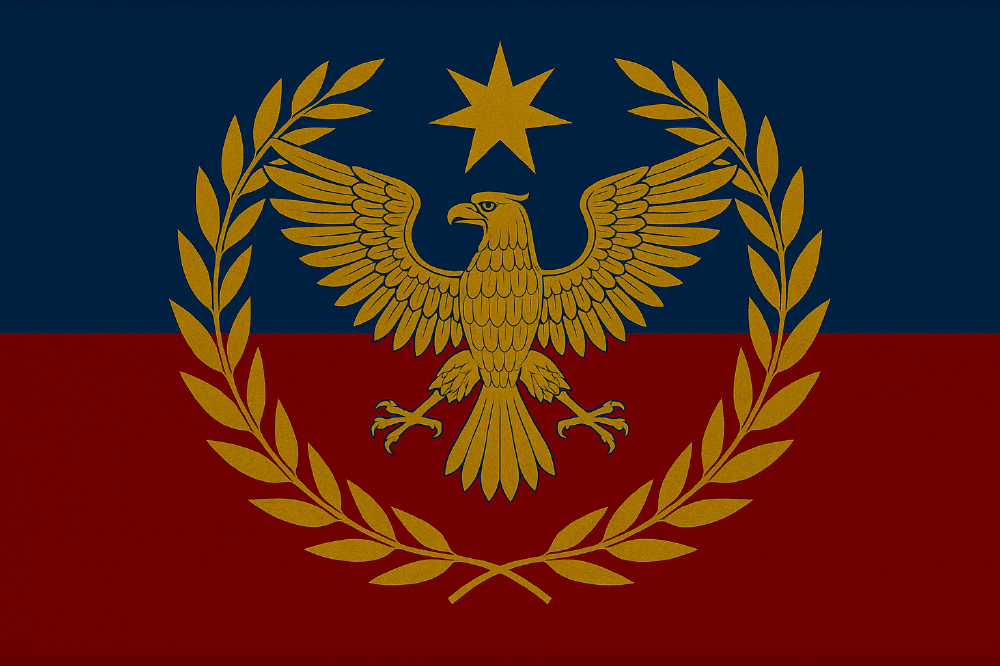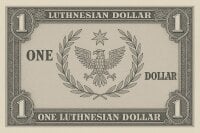| National Factbook |
| Flag: |

|
| Nation Name: |
Luthnesia |
| Leader Name: |
Ray Z |
| Currency: |

Luthnesian Dollar |
| National Animal: |

Golden eagle |
| History: |
Before foreign contact, Luthnesia was the homeland of the Atoshka Tribes, who believed the Great Northern Spirit, Siyatara, shaped the rugged mountains and vast rivers. Their spiritual beliefs are still honored at the Stone Circle of Iria in the capital, Hondorus.
In 1450, explorers from Varensia arrived on Luthnesia’s icy shores, forging the Marenholt Compact of 1502 with the Atoshka. Although it promised coexistence, the Compact ultimately laid the groundwork for Varensian colonization and the blending of cultures.
The 18th century was marked by fragmentation and competing powers, with Varensian governors and native chieftains vying for control. That changed in 1734 when Elaria Voss, a charismatic leader from the highlands of Alster’s Ridge, rose to prominence. Uniting the rival territories under her banner, she established the Kingdom of Luthnesia, wielding the fabled Sapphire Blade, a symbol of Luthnesian unity and pride.
During the 19th century, Luthnesia prospered. Its rich resources—silver, furs, and timber—fueled economic growth. Trading outposts along the Eldran Sea brought wealth and diversity to the kingdom’s shores.
Yet, this prosperity was shadowed by injustice. Industrial expansion pushed the Atoshka from their ancestral lands, sparking the War of the Frosted Plains (1910-1920). Led by the fierce Tavren Black Elk, the Atoshka fought for their rights and dignity. The war concluded with the Treaty of Serath Lake (1920), which recognized the Atoshka’s sovereignty in the Northern Tundra Province and forged the beginnings of reconciliation.
In 1925, inspired by the ideals of self-determination, Luthnesians abolished the monarchy and declared the Republic of Luthnesia. A new constitution laid the foundation for a parliamentary democracy, giving every citizen a voice in shaping their nation’s destiny.
Today, the Republic of Luthnesia thrives as a vibrant democracy. The cities of Hondorus and Dressuer bustle with cultural exchange and modern innovation, while the north remains a realm of awe-inspiring wilderness. Every spring, the country unites for the Festival of Renewal, planting trees and honoring the ancient Atoshka reverence for the natural world—a living testament to Luthnesia’s journey of healing and growth. |
| Geography |
| Continent: |
South America |
| Land Area: |
80,467.00 sq. km |
| Terrain: |
The Republic of Luthnesia is a land of diverse and dramatic landscapes, stretching from the icy expanses of the north to the fertile plains and temperate coasts of the south. Each region tells the story of the republic’s natural grandeur and cultural resilience.
In the Northern Tundra Province, the terrain is dominated by frozen tundras and vast taiga forests. Here, the ground is locked in permafrost for much of the year, and ancient coniferous trees stand as silent sentinels against the cold. The Frosted Plains sprawl across the horizon, where biting winds carve patterns into the snow. Towering cliffs rise over the Eldran Sea, whose icy waves crash against the rugged coastline—a realm of stark beauty and spiritual significance for the Atoshka Tribes.
Moving southward, the Alster Highlands emerge. This region is a land of mist-shrouded peaks, winding valleys, and deep fjords. Waterfalls cascade from snow-fed rivers, carving paths through the granite mountains. The highlands are steeped in legend: the birthplace of Elaria Voss, who united the republic centuries ago, and the setting for many of Luthnesia’s heroic sagas. Hidden glens and ancient trails weave through the landscape, connecting communities that have thrived here for generations.
Descending from the highlands, the terrain softens into the Emerald Valleys. These rolling lowlands are blanketed in lush meadows, dense woodlands, and rich farmland. The Serath Lake—a broad, clear expanse of freshwater—serves as both a vital resource and a spiritual gathering place. Villages of stone and timber nestle against hillsides, preserving centuries-old traditions while embracing the modern ideals of the republic.
Finally, the southern reaches of Luthnesia open onto the temperate coastal plains. These lands enjoy mild winters and warm summers, creating ideal conditions for agriculture. Vast fields of grain, orchards heavy with fruit, and vineyards stretch across the landscape. The bustling port cities of Hondorus and Dressuer anchor this region, serving as gateways to trade and cultural exchange across the seas. The southern coast’s sheltered bays and fertile lands make it the economic engine of the republic. |
| Highest Peak: |
Mt. Elderath,
3,784 meters
|
| Lowest Valley: |
The Lirwen Hollow,
-872 meters
|
| Climate: |
The Republic of Luthnesia experiences a wide range of climates across its diverse landscape, shaped by its vast latitudinal span and varied terrain. From the frozen tundras of the north to the temperate southern coasts, each region offers unique weather patterns that influence the lifestyles, cultures, and economies of its inhabitants.
Northern Tundra Province:
The far north of Luthnesia is dominated by a harsh subarctic and tundra climate. Winters are long, brutal, and dominated by darkness, with temperatures frequently plunging below -40°C (-40°F). Snow blankets the land for much of the year, and the ground remains frozen year-round in many areas due to permafrost. Summers are short and cool, lasting only a few weeks, with temperatures rarely rising above 10°C (50°F). The limited warmth allows only hardy vegetation such as mosses, lichens, and dwarf shrubs to survive. The tundra is also famous for the spectacular polar night in winter and the midnight sun during summer months. Frequent blizzards and fierce winds make travel difficult, reinforcing the resilience and close-knit nature of the native Atoshka communities.
Alster Highlands:
Moving south into the Alster Highlands, the climate shifts to a subalpine and alpine regime. The high elevation means cooler temperatures year-round, with snowy winters and mild summers. Snow often lingers on mountain peaks well into late spring, feeding the clear rivers and lakes below. The region receives significant precipitation, including heavy snowfall in winter and regular rainfall during the warmer months. The misty atmosphere and frequent fogs add to the mystical quality of the highlands, home to many of Luthnesia’s legends and historic sites. Summers here are short but pleasant, with temperatures ranging from 10°C to 20°C (50°F to 68°F), providing a brief growing season for hardy grasses and wildflowers.
Emerald Valleys:
Further south, the Emerald Valleys enjoy a temperate continental climate characterized by warm summers and cold winters. This region experiences four distinct seasons. Summers are warm and often humid, with average temperatures between 20°C and 25°C (68°F to 77°F), making it ideal for agriculture and forestry. Winters are cold but milder compared to the northern provinces, with temperatures averaging around -5°C to -15°C (23°F to 5°F). Snowfall is common but usually not as persistent as in the highlands or tundra. Spring and autumn are marked by vibrant changes in foliage, and these seasons are crucial for planting and harvesting crops. Rainfall is fairly evenly distributed throughout the year, supporting the fertile soils and dense forests of the valleys.
Southern Coast:
The southern coastal areas of the Republic of Luthnesia enjoy the most moderate and pleasant climate. Classified as temperate maritime, this region experiences mild winters and warm summers. Winter temperatures rarely drop below freezing, typically hovering around 0°C to 5°C (32°F to 41°F), while summers can reach comfortable highs of 25°C to 30°C (77°F to 86°F). The proximity to the sea moderates temperature extremes and brings frequent, gentle rains throughout the year. Fog and mist are common in the early mornings and evenings, especially during spring and autumn. The southern coast’s climate supports extensive agriculture, including vineyards, orchards, and crop fields, making it the agricultural heartland of the republic. The mild climate also encourages bustling port activities in cities like Hondorus and Dressuer, fostering trade and cultural exchange. |
| People & Society |
| Population: |
4,415,051 people |
| Demonym: |
Luthnesian |
| Demonym Plural: |
Luthnesians |
| Ethnic Groups: |
White, non-Hispanic - 58.0%
Hispanic - 21.0%
Black - 21.0% |
| Languages: |
English - 78.4%
Spanish - 13.4%
German - 8.2% |
| Religions: |
Christianity - 62.0%
Islam - 27.2%
Hinduism - 10.8% |
| Health |
| Life Expectancy: |
80 years |
| Obesity: |
5.7% |
| Alcohol Users: |
42.7% |
| Tobacco Users: |
21.2% |
| Cannabis Users: |
1.8% |
| Hard Drug Users: |
1.2% |
| Economy |
| Description: |
The Republic of Luthnesia pursues a balanced, forward-looking economic policy framework that emphasizes sustainability, innovation, social equity, and respect for indigenous rights. The government’s policies aim to foster long-term prosperity while protecting the country’s diverse environment and cultural heritage. |
| Average Yearly Income: |
$112.21 |
| Gross Domestic Product (GDP): |
$16,346,521,682.00 |
| GDP per Capita: |
$3,702.45 |
| Gross National Income (GNI): |
$16,165,760,210.00 |
| Industries: |
The Republic of Luthnesia supports a diverse and dynamic industrial sector shaped by its unique geography, resource wealth, and commitment to sustainability. Its industries reflect a careful balance between tradition and modern innovation, emphasizing eco-friendly practices, cultural heritage, and technological advancement.
1. Mining and Natural Resources
Mining remains a foundational industry, particularly in the mineral-rich Northern Tundra Province. The republic extracts silver, copper, and rare earth elements crucial for electronics and renewable technologies. Modern mining operations use advanced environmental safeguards to minimize ecological damage, including strict waste management and land reclamation efforts.
Forestry is also significant, with sustainable timber harvesting from boreal forests supplying raw materials for construction, paper, and furniture. The timber industry collaborates closely with indigenous Atoshka communities to preserve forest health and biodiversity.
2. Agriculture and Food Production
The fertile Emerald Valleys and southern coastal plains form Luthnesia’s agricultural heartland. Farming here is characterized by a blend of traditional methods and modern sustainable techniques. Major crops include grains (wheat, barley), root vegetables (potatoes, carrots), fruits (apples, berries), and specialty products like hops for brewing.
Livestock farming—especially cattle, sheep, and free-range poultry—is vital, with strict animal welfare standards and environmentally conscious pasture management. The southern vineyards and orchards produce acclaimed wines and ciders, positioning Luthnesia as a growing player in the international gourmet food market.
Food processing industries in cities such as Hondorus and Dressuer add value to raw products through packaging, preservation, and artisanal food production, including cheeses and cured meats.
3. Renewable Energy and Clean Technology
Luthnesia has become a regional leader in renewable energy, leveraging its natural assets to power its economy sustainably. Hydroelectric plants harness the glacial rivers of the Alster Highlands, supplying clean energy nationwide.
Wind farms along the southern coast complement hydropower, while solar installations are increasingly common in urban and rural areas alike. The country actively invests in emerging clean technologies such as energy storage systems, smart grids, and bioenergy.
Research and development hubs foster innovation in green tech, developing solutions for energy efficiency, carbon capture, and sustainable agriculture, positioning Luthnesia as a knowledge-based economy.
4. Manufacturing and Light Industry
Luthnesia’s manufacturing sector focuses on light, high-value production. Factories in Hondorus and Dressuer produce precision instruments, electronics components, and eco-friendly building materials.
The timber industry supports furniture making and specialty wood crafts, blending traditional skills with modern design. Small-scale artisanal industries thrive alongside larger plants, preserving cultural heritage while meeting contemporary market demands.
Food processing and packaging plants add further depth, supporting both domestic consumption and export markets.
5. Tourism and Cultural Industries
Tourism is a vital and growing industry, centered on Luthnesia’s natural beauty, historic sites, and vibrant cultural traditions. The pristine wilderness of the northern tundra and the Alster Highlands attract eco-tourists, hikers, and adventure seekers.
Cultural tourism thrives around ancient Atoshka heritage sites, historic towns, and festivals celebrating the republic’s diverse communities. Cities like Hondorus and Dressuer offer museums, theaters, and galleries that showcase local art, music, and crafts.
Ecotourism initiatives promote responsible travel, supporting conservation and local economies while educating visitors about Luthnesia’s unique environment and history.
6. Information Technology and Services
The republic’s growing tech sector focuses on software development, environmental modeling, and digital services. Urban centers host innovation clusters where startups and established firms collaborate with universities on projects ranging from sustainable agriculture tech to climate analytics.
Financial services, healthcare, and education provide a strong service sector base, ensuring high living standards and social stability. |
| Military |
| History: |
The Luthnesian Defense Forces (LDF) are a professional, volunteer military dedicated to defending the republic’s sovereignty, supporting regional stability, and participating in international peacekeeping. The LDF is known for its focus on modern technology, rapid response, and environmental sustainability.
⸻
Structure and Branches
The LDF is divided into three main branches, each tailored to Luthnesia’s unique geography and strategic needs:
• Army (Land Forces)
• Navy and Coastal Defense
• Air and Space Command
Additionally, specialized units include a Cyber Defense Unit and an Emergency Response Corps.
⸻
Army
The Luthnesian Army specializes in operations across varied terrains—from the arctic north to mountainous and urban areas.
• Mountain Infantry Brigades: Expert in cold-weather survival and combat in the rugged Vyrnath Mountains and tundra regions.
• Mechanized Units: Use modern, environmentally conscious armored vehicles designed for mobility and low impact.
• Special Forces: Elite units trained in reconnaissance, counter-terrorism, and unconventional warfare, often collaborating with indigenous Atoshka guides for terrain expertise.
The army actively participates in international peacekeeping and humanitarian missions.
⸻
Navy and Coastal Defense
The republic’s extensive Eldran Sea coastline requires strong naval capabilities:
• Patrol Fleets: Fast vessels with advanced surveillance protect fishing zones, combat smuggling, and conduct rescue operations.
• Submarine Unit: Diesel-electric submarines provide stealth reconnaissance and deterrence.
• Coastal Defenses: Missile batteries and radar stations defend key ports like Hondorus and Dressuer.
The navy also aids in environmental protection and emergency response.
⸻
Air and Space Command
Responsible for air defense, reconnaissance, and support to other forces, this command operates:
• Multirole Fighter Squadrons: Equipped for air superiority, interception, and ground support.
• Transport and Surveillance Aircraft: Provide logistical support and border monitoring.
• Unmanned Aerial Vehicles (UAVs): Used for intelligence gathering, disaster management, and environmental monitoring.
• Space Operations: Satellite systems offer early warning, communications, and environmental data.
⸻
Cyber Defense and Emergency Response
• The Cyber Defense Unit safeguards government and military networks against cyber threats and misinformation.
• The Emergency Response Corps coordinates disaster relief efforts for natural events like floods and forest fires, utilizing military logistics and expertise to support civilians.
⸻
Conscription and Reserves
While primarily volunteer-based, Luthnesia maintains a mandatory reserve service for citizens aged 18 to 35. Reservists receive training in civil defense, first aid, and rapid mobilization to supplement the active forces when needed.
⸻
Defense Policy and International Cooperation
Luthnesia follows a defensive doctrine focused on deterrence and multilateral alliances. It actively contributes to Rose Alliance peacekeeping and regional security efforts. Environmental sustainability is integral to military operations, with initiatives to reduce the carbon footprint and promote green technologies. |
| Soldiers: |
0 |
| Tanks: |
10,000 |
| Aircraft: |
1,500 |
| Ships: |
0 |
| Missiles: |
0 |
| Nuclear Weapons: |
0 |
| Last Updated: 05/31/2025 10:31 am |



















